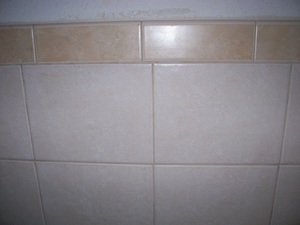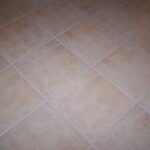If you are considering tile as your floor of choice, you must make sure that the surface is strong enough to support the tiles or all of your hard work putting the tile in will be for nothing when the tiles inevitably start to crack or break. This is called providing a substrate for the job and it simply means that you are creating a hard enough surface for your tiles to rest upon, that will not readily expand and contract. If you determine that your floor is in need of this strengthening, backer board is fantastic for getting the job done right. If you are putting the backer board on top of wood flooring, sealing it with a waterproofing is recommended because even though backer board itself is not affected by water, it can allow moisture particles to seep through that could damage the underlying floor.
First of all you want to sweep your floor clean of all debris. This remains true throughout the entire process. If while working crumblings or dust particles get on the floor, sweep them up. Keep a whisk broom and miniature dust pan handy for quick pick ups.
Now you want to measure your floor and cut your backer board sheets to the proper size. Consider the seams and cut them so they aren’t in synch with any seams on the existing floor. Make sure you leave spaces between sheets (usually 1/8 of an inch) and between any place the backer board is going to meet a solid, vertical surface (usually ¼ of an inch). Lay your pieces out first in a dry run, to make sure you have enough cut and that they are sized properly. This is an important step and almost always requires a revision in cutting. It is better to catch these size discrepancies now than it would be to have to try and fix them after the mortar has been put into place. Another note here is that you want your backer board to be as sturdy as possible, so leave it in as big of sheets as you can readily get away with to help with the strength. Smaller pieces will probably be needed in some areas, but keep them to a minimum.
Mix your thin-set mortar that is designed for backer boards according to the directions that come with it. Spread your mortar thinly with a notched trowel evenly over the existing floor and then press a piece of backer board firmly down into the mortar. You can either screw then screw the boards in place with specialized backer board screws by screwing them at the ends of each board, or by screwing them in with a continuous pattern of screws that are set about six to eight inches apart.
Taping your joints will be your final step in getting the back board finished. Use tape specifically for this type of job (not paper tape) and set it in place with your notched trowel and your thin-set mortar. Make sure the mortar gets into the joints very liberally and then smooth any excess oozing out of the edges to make sure you have a smooth finish. Allow to dry.
You can use plywood instead of backer board, but the backer board is more sound and since it is designed for exactly this purpose (especially in areas where moisture or water will be common), more highly recommended. When you choose your backer board, make sure it is not so thick that it will raise the floor higher than you want it to be when finished. Remember, the tile you put on it is going to raise the level as well, so take great care in this step. You want the step transition from room to room to go smoothly, and you want any existing features you remove to install the tiles to reinstall correctly once the flooring is in place.
You are now finished with your substrate and can begin the process of applying your tiles.



